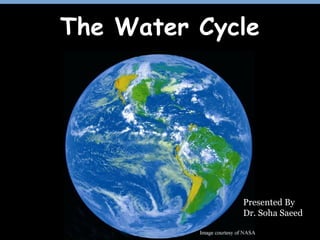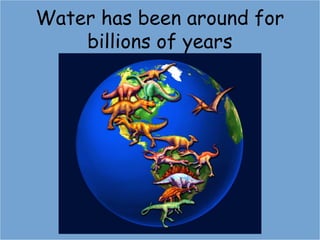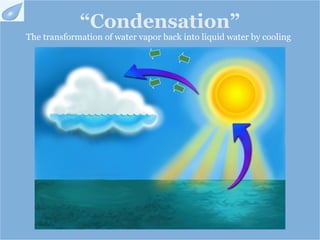The water cycle
- 1. The Water Cycle Presented By Dr. Soha Saeed
- 2. Water has been around for billions of years
- 3. Water gets recycled over and over again Image courtesy of US Environmental Protection Agency
- 4. How rain is formed?
- 5. What is the Water Cycle? Evaporation Condensation Precipitation
- 6. “Evaporation” The conversion of water from a liquid to a gas
- 7. “Condensation” The transformation of water vapor back into liquid water by cooling
- 8. “Precipitation” Rain, hail, or snow falling from the clouds due to the condensation of water With enough condensed water, you get rain!
- 9. Questions: • How rain is formed? • The process in which the liquid turns to gas is called? • The process in which the gas turns into liquid is called ?
- 11. The End Any questions??? Thank you
Editor's Notes
- When the first fish crawled out of the ocean onto the land, the same water you brushed your teeth with this morning was part of that ocean. When the Brontosaurus walked through lakes feeding on plants, the water you get from the drinking fountain here at school was part of those lakes. There is approximately the same amount of water on Earth today as there was when the Earth was formed. Water is continually recycled in the Earth's water cycle.
- Today we are going to talk about how the water from billions of years ago has been recycled by the earth and is being used by each one of you today. The process of the earth recycling water is called the water cycle. As water goes through this process it changes states like we discussed in the previous PowerPoint. QUESTION: What are the three states or forms of water? ANSWER: Solid, liquid and gas
- The water cycle is made up of five processes; transpiration, evaporation, condensation, precipitation, and accumulation. Let’s investigate how each of these processes work to keep water from billions of years ago moving around the earth.
- Evaporation is a critical component of the water cycle, which is responsible for clouds and rain. Solar energy drives evaporation of water from oceans, lakes, moisture in the soil, and other sources of water. QUESTION: How does evaporation relate to weather? ANSWER: Evaporation is responsible for clouds and rain.
- The water seen on the outside of a cold glass on a hot day is condensation. Condensation is the changing of water from a gaseous state back to a liquid state in the form of clouds. QUESTION: How is condensation related to weather? ANSWER: Condensation forms clouds, which can produce rain, hail, or snow.
- Precipitation is a major component of weather and of the water cycle. Precipitation is responsible for depositing most of the fresh water on the planet.










